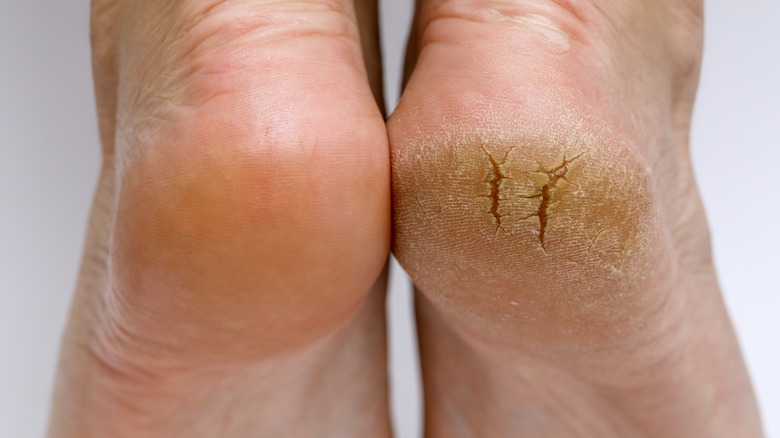What Causes Spots On The Bottom Of Your Feet?
Humans walk a lot. We use our feet every day — whether we're trying to reach the daily step goal of 10,000 steps or lacing up for a fall marathon. That being said, it's important to take good care of your feet by regularly inspecting them, since they're constantly working hard. Consider looking for spots on the bottom of your feet and take notes of any pain.
If red spots appear when inspecting your foot, that may be a warning sign of a reaction. One common culprit that causes skin changes is Athlete's foot, which is a contagious fungal infection that infects the skin (via Cleveland Clinic). This fungal infection is also known as tinea pedis and generally occurs on the soles of the foot or between the toes. It can cause redness, itchiness, burning, and scaly skin, points out Medline Plus. Typically over-the-counter antifungal creams are recommended by doctors to treat it, but in severe situations, prescription medications are given.
In addition, red spots may also indicate an insect bite, psoriasis, blisters, or an allergy to plants, explains Healthline. Allergies to any plants (i.e. grass) can trigger an allergic reaction and cause itchiness, bumps, and a red rash. In these cases, it's important to identify what plant triggered this reaction. Talk to your doctor if you suspect you have an allergy. Healthline shares that over-the-counter antihistamines and cortisone creams may be prescribed by your doctor.
What causes discoloration on your feet?
When self-inspecting your feet, it's also important to look for any discoloration, abnormalities, or texture changes. For instance, hard and thick skin that's dull in appearance could indicate a corn or callus (via American Podiatric Medical Association). This typically results from excessive rubbing of the shoe on a bony spot on the foot. According to Medline, calluses are generally found on the soles of the foot, while corns are formed on the toes.
However, a more serious discoloration to be mindful of is blackish-brown spots on the foot, as this may be an early sign of melanoma, a skin cancer (per American Podiatric Medical Association). While it may resemble a mole, this melanoma may also look like an ingrown nail, plantar warts, or bruises. It can even appear red like a blood blister with asymmetrical borders and shapes, points out Healthline. This type of skin cancer can grow and spread deeper into the layers of skin. When this happens, the cancer can expand through both the blood vessels and the lymphatic system, shares American Podiatric Medical Association. The Centers for Disease Control and Prevention (CDC) recommends using the A-B-C-D-E of melanoma when checking the spots on the bottom of your feet. This means examining the asymmetry, border, color, diameter, and to check if it's been evolving. If you notice any changes in color, pain, or new growth, talk to your doctor.


